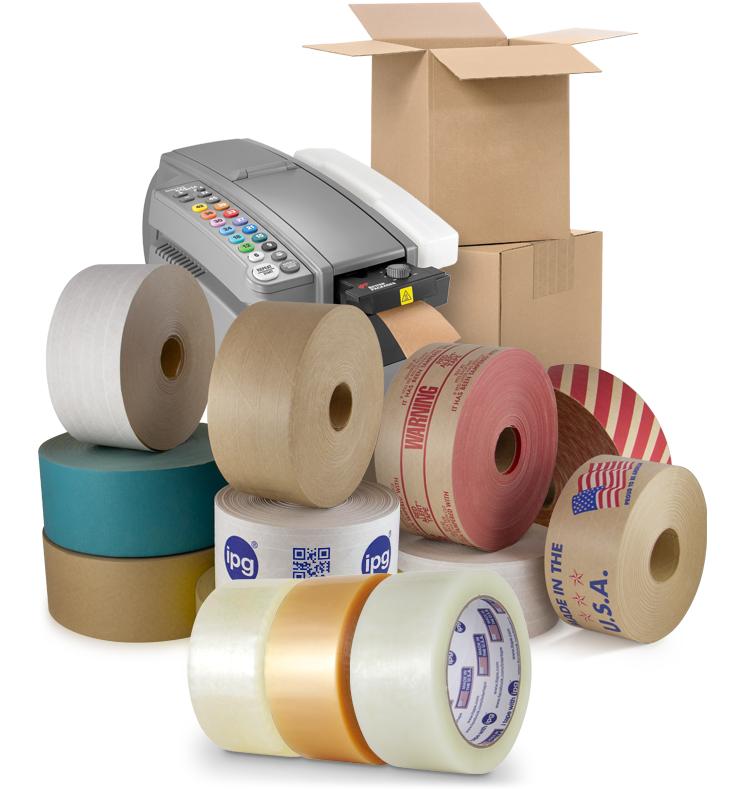UNLOCKING SUCCESS:
Choosing the Ideal Packaging Tape for Your Business

When your shipments arrive at your buyer's doorstep, what impression are you making? If the package is damaged, with loose tape and exposed contents, it can speak volumes about your brand's commitment to quality and customer service.
Often, the difference between a secure and compromised package comes down to the type of tape that the company uses. This might seem like a small decision, but it can have lasting implications. Instead of choosing the cheapest tape on the market, or the closest one at hand, it's important to think carefully as you consider all the different kinds of tape available.
Let's take a closer look at why this decision matters, the various options to choose from, and how to know which one is right for you.
Download our
eBook Today!
Our guide to choosing the ideal packaging tape for your business is a great eBook to have on hand to help answer common questions from your team and overcome objections when making a packaging tape purchasing decision.
Why Does Your Shipping Tape Matter?
Regardless of the type of goods you're selling, presentation will always matter.
A damaged package is more than an embarrassing setback. It can cost your company significantly in these three ways:
- Loss of reputation
- Product loss, damage, or contamination
- Decreased productivity and material waste
Let's break these down a little more...
Reputation Loss
Customer expectations are always changing. In today's Digital Age, for instance, personalization and customization is key. Buyers want to know that brands take their business seriously, and are doing everything in their power to optimize their shopping experience.
Shipping plays a major part in this service. Modern consumers don't just want high-quality goods at an economical price point. They want those goods shipped immediately, arriving to them as soon as possible.
If their item arrives damaged, they're unlikely to buy from you again. In fact, studies show that 91% of people will abandon a brand if they have even one unfavorable experience with it.
The bottom line: It isn't worth sacrificing your reputation to save a few bucks on shipping. Investing in quality packaging materials is a must if you want to build customer loyalty -- and your bottom line.
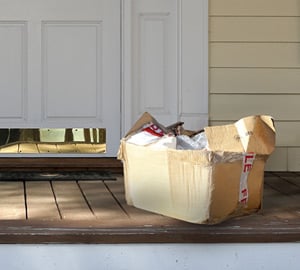 Product Loss, Damage, or Contamination
Product Loss, Damage, or Contamination
The right packaging tape will keep your item secure through every step in the delivery process. Conversely, the wrong type of tape can expose it to myriad risks as it travels from one destination to the next.
If your package isn't correctly taped, the product inside of the carton could fall out, become damaged, or come into contact with substances that can contaminate it. When this happens, your company will be responsible for fixing the issue. This creates more work for your employees and cuts into any profits you make from the sale.
Decreased Productivity and Material Waste
Part of being a responsible, supportive employer is equipping your team members with the tools they need to perform their jobs effectively. This applies to every detail, including the tape they use.
If they're required to work with the wrong material, the packing and shipping process naturally slows. Materials are wasted, frustration mounts, and morale takes a nose dive.
While these issues can occur when you use the wrong tape, the good news is that you can mitigate these risks by choosing the right packaging tape from the start.
That said, how can you make sure you're using the correct kind? To start, you need to understand all of your options.
Know the Most Common Kinds of Packaging Tape
There are two main types of packaging tape to choose from. These include:
- Pressure-sensitive tape
- Water-activated tape
These tapes differ in many ways, from their physical properties and appearance to their application and performance. While one might be more affordable or accessible than the other, it's important to think about which tape you need for your specific operations and let that drive your purchasing decision.
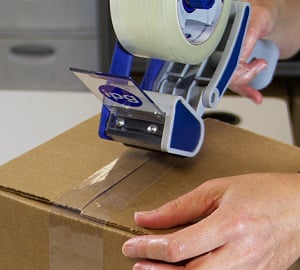 Plastic Pressure-Sensitive Tape
Plastic Pressure-Sensitive Tape
Plastic pressure-sensitive tape (PST) is made by applying a dry adhesive onto a thin plastic film, both of which are petroleum-based substances. You can find this kind of tape in a variety of different strengths and sizes. Some is marketed specifically as moving tape, while other kinds are designed for shipping and packaging.
Moving tape isn't usually as strong as packaging tape, because the items aren't handled as much during transit. There's also less risk of theft since the same team usually handles the package for the duration of the move.
On the other hand, packaging tape is usually thicker, stickier, and more durable. This type of PST is ideal for packages that have to go through a wide distribution network before reaching their destination.
If you've ever used a handheld tape gun, you were likely using PST. Once the tape dispenses from the gun, the user applies gentle pressure with their fingers or palms to secure it in place. This adheres the tape to the surface of the package.
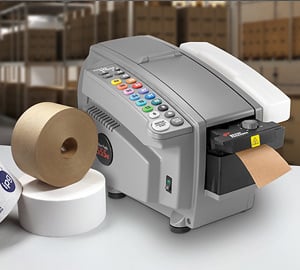
Paper Water-Activated Tape
Paper water-activated tape (WAT) is usually made of white or natural paper and contains a starch-based adhesive. WAT is available in two forms: paper tape (unreinforced) and reinforced. You can find it in many different widths and thicknesses.
A few other names for WAT include:
- Gum tape
- Kraft paper tape
- Paper packing tape
- Brown paper tape
Unlike the tape gun used with PST, WAT is usually applied via a manual or electric tape dispenser. As you cut the tape to the correct length, the dispenser will automatically apply a certain amount of water to the material, which activates the adhesive.
When applied to a package, WAT penetrates the surface and forms a tamper evident, permanent bond. This makes it very secure, but if you need even more holding power, look for WAT that contains reinforcing strands. One example is our Curby Tape, which features fiberglass and polyester reinforcements.
Compare Key Features
Torn between using PST or WAT to secure your packages? As you evaluate your options, keep these features in mind:
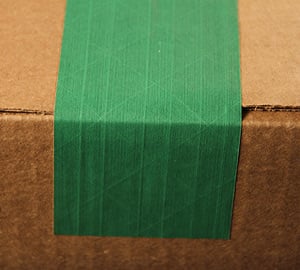
Between PST and WAT, most users agree that WAT is stronger. As this kind of tape has the word "paper" in its name, you might think it would be flimsy and less secure than its plastic counterpart, but this isn't the case.
As mentioned, WAT permanently bonds with the carton material upon application. It essentially "becomes one" with the package, making it nearly impossible to tear off with your bare hands. This is especially the case if you invest in reinforced varieties, which are made even stronger by the addition of the reinforcements.
If you have a heavy box to secure, WAT is typically your best bet. Most of the time, you'll only need one strip to keep the major flaps closed.. While you may be able to achieve a similar level of strength with PST, you'll need multiple strips of tape to get the same effect.
Whether you're shipping an item a few minutes down the road or all the way around the world, you need a tape that will hold up as it's jostled and tossed about. This is another area where WAT shines.
This type of tape is much less likely to slip off or become damaged during shipment. Instead, it creates a weld that is tamper evident and will maintain a positive seal throughout the shipping process. Even in unfavorable conditions (e.g. extreme temperatures, dirty/dusty environments), it will maintain its hold.
While you'd like to think that your package would arrive securely at its end point without any foul play, the reality is that thefts can occur at any point. One study found that 1.7 million packages go missing every day in the U.S., costing businesses roughly $25 million daily. That number has only risen since the pandemic, with mail theft complaints rising by 161% in 2020 alone.
To keep your packages (and the contents within them) secure, you need tape that will protect against all kinds of theft or vandalism. PST is especially vulnerable to “press and grab” thefts, as it can separate from the surface of the package.
When analyzing different types of tape, it's also important to think about how easy and efficient it is for your workers to use. Tape that's user-friendly and doesn't take long to apply can make your warehouse instantly more productive.
When labor costs are low, profitability can rise, especially in high-volume environments where large orders are processed daily. While tape guns are portable and easy to store, they can also be bulky and cumbersome to use. In addition, workers will have to apply multiple strips of PST to equal the strength of just one piece of WAT.
Most WAT dispensers are designed to be small and space-saving in nature, allowing them to fit easily into any packaging line layout.
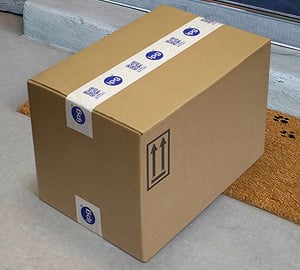 As long as your items arrive safely and in good condition, you might think the appearance of your packaging tape doesn't matter. However, it's important to keep aesthetics in mind when sealing boxes. According to one report, 72% of Americans say that the design of a product's packaging influences their purchase decision and 67% pay close attention to the type of packaging materials used.
As long as your items arrive safely and in good condition, you might think the appearance of your packaging tape doesn't matter. However, it's important to keep aesthetics in mind when sealing boxes. According to one report, 72% of Americans say that the design of a product's packaging influences their purchase decision and 67% pay close attention to the type of packaging materials used.
When you use just one strip of WAT, your packages can maintain a clean, minimalistic appearance. You don't have to worry about overlapping strips of tape sticking out all over the place. This might seem like a small touch, but it can keep your current customers happy and could convert a first-time buyer into a more loyal brand follower.
If you want to enhance the look of your packages even more, consider using WAT in a simple, neutral color. For instance, our 260 is available in three different shades: Natural , Snow White, and Super White.
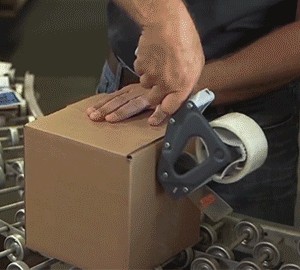 Did you know that a movement as simple as applying tape can lead to worker injury? As an employer, you're legally obligated to keep your employees' safety and protection top of mind. Asking them to use a tape gun to apply PST could put excess strain on their hand, arm, and finger joints, leading to a repetitive motion injury, such as tendinitis or bursitis.
Did you know that a movement as simple as applying tape can lead to worker injury? As an employer, you're legally obligated to keep your employees' safety and protection top of mind. Asking them to use a tape gun to apply PST could put excess strain on their hand, arm, and finger joints, leading to a repetitive motion injury, such as tendinitis or bursitis.
While these injuries are usually minimal in nature, they could render an employee unable to work for a certain amount of time. In severe cases, they may even require surgery, which your organization could be responsible for covering.
Applying WAT is a much easier task. Moistening and dispensing the tape is simple, whether the user is doing it manually with a push button or working with an electric dispenser. Even the application motion is more natural and flexible than with a tape gun, lowering the risk of injury.
When choosing your tape, it's also helpful to look for one that's manufactured in accordance with Underwriter Laboratory (UL) standards for user safety and accessibility.
As you make your warehouse budget, you'll need to know how PST and WAT compare in terms of price. As with most things in life, you'll pay a little more for the high quality that WAT provides.
However, before you reach for the less expensive option to save a little money, consider the bigger picture. When calculated on a per-package basis, PST does cost less per foot than WAT, but you'll need more of it to properly close your package.
Shop Our Different Kinds of Tape Today!
As you can see, there are many considerations to keep in mind as you shop for the best tape for your warehouse! Choosing the right option is key to securing your packages, boosting your brand, and keeping your consumers happy.
At IPG, we're proud to be a leading global provider of packaging and protective solutions. We offer many different kinds of tape, as well as other solutions, including case packers, carton sealing machines, and more.
Join our B2B Customer Center today to learn more and start shopping!
